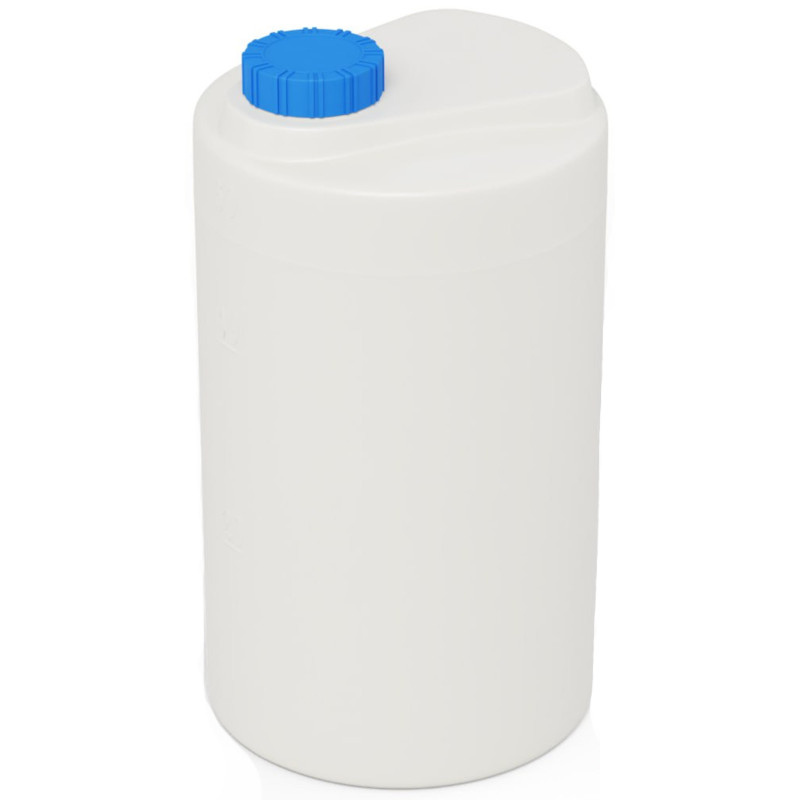Transport tank Verticon Chemo-Transport 200l
- Capacity from 60 to 200 litres
- For drinking water and other chemicals
- Airtight screw cap included
Transport tank Verticon Chemo-Transport

The Verticon Chemo-Transport tank is dedicated to the storage of medical solutions. In addition, it is also ideal for transporting various chemicals or water. A table of chemical resistance is available in the attachments. The container is suitable not only for industrial applications, but also for household use. The side wall features a scale in litres. This makes it very easy to determine the filling level. The Verticon transport tank has a flat bottom and a wall thickness of 3.5 mm. This gives it strength and stiffness. In addition, it is fitted with a screw capto ensure a airtight seal. The containers are available in blue and white as standard. Tanks in a different colour are available on request.
| Type | Capacity [l] | Height [mm] | Tank diameter [mm] | Neck diameter [mm] | Wall thickness [mm] |
| V-60 | 60 | 663 | 363 | 110 | 3,5 |
| V-130 | 130 | 870 | 468 | ||
| V-200 | 200 | 850 | 580 |
*Dimensions may differ slightly due to the production process. The measurement tolerance is 5-10 % from the nominal values in the table.
Specific References
- ean13
- 5905567314506
DRINKING WATER TANKS - INSTALLATION OF CONNECTIONS
Drinking water tanks are manufactured using rotomoulding technology, which allows the tanks to be produced as a whole, without the need to weld individual components together, which has a beneficial effect on the mechanical strength of the tank. Polyethylene tanks are lighter than their steel or resin counterparts. Tanks made of non-toxic polyethylene are ideal for storing foodstuffs as well as technical substances used in various production processes. The polyethylene material prevents the growth of algae by being impermeable to sunlight. The tank can withstand temperatures from -20 to +80 °C.
The proposed tanks are ideal for:
-storing drinking water or other food-grade liquids both indoors and outdoors,
-the construction of buffer tanks to be used in the event of pressure drops or water shortages,
-to store water for fire-fighting purposes, laundry or dishwashing,
-supplying water in the event of a shortage of water on distribution vehicles,
-collecting and using rainwater, which can be used for irrigation or toilet flushing, etc.
Installation of spigots
The polyethylene tanks have a polypropylene lid equipped with a vent with anti-fungal protection and threaded connections. Additional inlet and outlet openings can be provided on request. Here is how to properly assemble the spigots.
1) Preparation of the hole
The hole for the spigot should be drilled with a hole saw in the centre of a flat surface located at the bottom of the tank, approximately 10 cm above the bottom of the tank. The diameter of the hole should be equal to the diameter of the spigot.
2) Installing the spigot
Place a gasket on the spigot and then, from the centre of the tank, pass it through the pre-drilled hole. If there are any problems with translation, the spigot can be lightly hammered in with a rubber mallet. Place a second gasket and nut on the spigot protruding from the tank.

3) Tighten spigot
Tighten the nut all the way, e.g. with a pipe chain spanner. Then clean the tank and the spigot of any shavings that may have occurred during assembly.

All tanks have the necessary approvals and certificates to allow the tanks to come into contact with foodstuffs.











